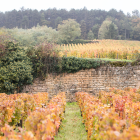Burgundy’s wine industry is facing increasing pressures as climate change takes hold of the region.
Last year saw two key events for the climate change narrative. Firstly, the IPCC’s report that the current and untenable climate situation represents a ‘code red’ for humanity, and secondly, COP26 in Glasgow, which bought together leaders from all over the world to discuss the increasing global climate crisis.
The impacts of our changing climate are already being felt far and wide, and the wine industry is no exception. Last year also saw widespread bush fires in winemaking regions in California and Australia, devastating floods across winemaking regions of Germany, and in Burgundy, a fourth consecutive growing season marred by extreme heat and frost. Historical and predictive data suggests we can expect the same this year, too.
The climate is both a friend and foe to winemakers. The right conditions can yield exceptional vintages, and for some varieties in certain regions, increasing temperatures mean juicier and more flavourful grapes, much to the delight of winemakers. For others, however, the unpredictability of the weather means many estates are having to completely rethink their operations.
Burgundy’s challenge
Burgundy faces a particularly unique challenge in that its wine industry is largely built around two grapes, Pinot Noir and Chardonnay, which are not – unlike Bordeaux – usually blended with other varieties. Pinot Noir does not cope well in extreme heat, as its thin skin puts it at greater risk of sunburn, while it is particularly susceptible to disease pressures associated with heavy rain. Chardonnay is slightly more resilient, but is more at risk of spring frost, another curse of climate change that saw massive crop losses in 2021.
Even if grapes survive the growing season, there’s no guarantee that they’ll be up to the exacting standards many estates have built their prestigious reputations upon. Once upon a time winemakers’ predominant concern was getting enough sugar ripeness in the grapes, but now with alcohol levels rarely lower than 14%, it’s about retaining balance to ensure the freshness and elegance that defines fine Burgundy.
There are options, in the short-term. Burgundy’s winemakers have a wealth of knowledge, expertise and tools to help protect against some of the impact of climate change. Ploughing is increasingly avoided, as it releases much-needed moisture from the soil. Cover crop can be useful in avoiding erosion, and growers may choose to delay pruning, which can in turn delay budburst, mitigating the ill effects of frost. Some producers are increasingly favouring thicker, taller and leafier canopies to shield grapes from the sun, and teams are being mobilised to pick at a moment’s notice as harvests start earlier and earlier every year.
But these measures bring their own complex considerations. Cover crop, for example, comes at a cost of soil nutrients, while thicker canopies mean less airflow and a more humid environment, and therefore greater disease risk. Above all, the changing climate will outpace these short-term efforts, so producers are considering bolder action.
Upending the status quo
Traditionally, many of Burgundy’s best vineyard sites have been sun-soaked and mid-slope, with good exposure and drainage. Now, plots that were previously unviable – and historically deemed ‘lesser’ – are also producing high quality wines due to their cooler, temperatures and deeper, clay-rich soils. Similarly, many producers are paying closer attention to mature vines, as their deeper root systems are able to reach water reserves and with age are thought to gain a natural stability, enabling them to withstand more extreme temperatures.
Winemakers’ increasing focus on alternative sites poses some interesting questions: Will Burgundy’s classification system change in line with the climate? Will Burgundy’s emphasis on terroir shift in the future?
Traditionalists will no doubt be aghast at such a prospect, but the increasingly clear impacts of climate change means Burgundy’s winemakers are considering more daring measures still: new grape varieties.
There are currently 47 Pinot Noir clones and 40 Chardonnay clones, but some forward-thinking winemakers believe the changing climate represents an opportunity to explore new varieties in Burgundy altogether – a move which mirrors the increasing popularity of frost-resistant Aligoté, which is already found in Burgundy in small (but growing) quantities. Some suggest its high acidity could be a solution for retaining freshness in the region’s whites.
Just as Bordeaux recently permitted a number of new, more resilient grape varieties, the BIVB (Burgundy Wine Board) intends to present a shortlist of experimental varieties to the INAO (The National Institute of Origin and Quality) for approval in Burgundy. Previously neglected or abandoned grapes such as Aubin, Roublot, Sacy, Melon, César and Tressot are likely to feature, some of which are already planted in small amounts around the region. Some makers, meanwhile, are even speculating on the varieties from beyond Burgundy’s borders, such as Jura or the Mediterranean. Cabernet Franc and Syrah have been touted on occasion, much to the chagrin of Burgundy’s winemaking fundamentalists.
Indeed, Burgundy’s rich winemaking history is one built on tradition and ancestral knowledge, and many fear that upending business as usual will jeopardise everything the region stands for. Others, meanwhile, believe that a lack of action will simply decimate prestigious winemaking in Burgundy altogether, citing an ‘adapt or die’ ethos. It’s clear then that Burgundy’s wine industry faces some tough decisions, but like the climate, change of some kind is inevitable.






